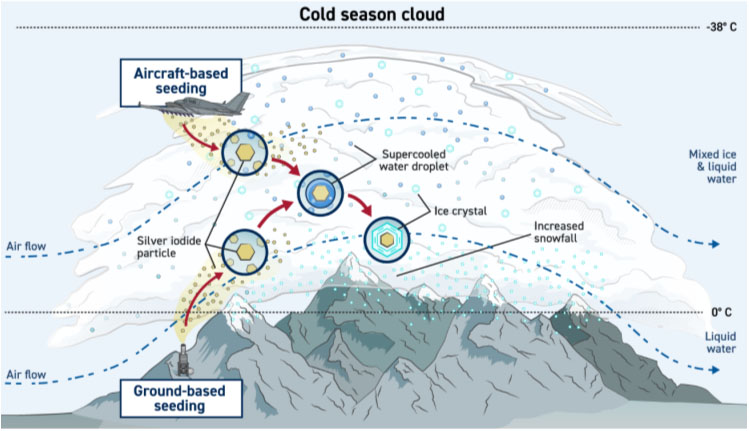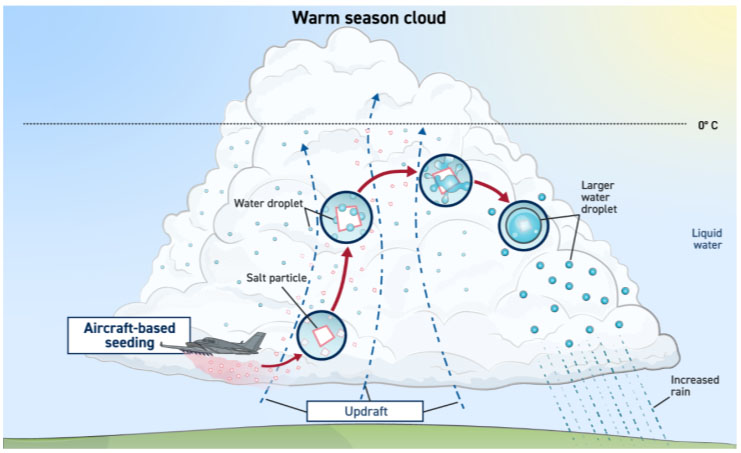Weather Warfare and Indian Armed Forces
- October 15, 2025 |
- Issue Brief
Summary
India has developed a strong scientific capacity for cloud seeding but lacks a tri-service framework. Further civil–military integration is necessary to convert civil expertise for military purposes.
Introduction
Artificial rain or cloud seeding has marked the shift from weather as a constraint to weather as a variable that can be manipulated. Artificial rain involves introducing particles into clouds, which can stimulate precipitation. There are two common ways to achieve artificial rain. Glaciogenic seeding spreads ice-forming agents such as silver iodide into supercooled clouds, producing ice crystals that trigger rainfall or snowfall. In Hygroscopic seeding, sodium chloride is dispersed, which enhances droplet growth until they fall as rain. Delivery systems include aircraft, rockets and ground-based generators. In recent times, autonomous aerial vehicles (AAVs) have been used extensively.
The effectiveness of cloud seeding varies with the climatic zone. In cold mountainous regions (Figure 1), glaciogenic methods can increase snowfall by 10–15 per cent; whereas in warm humid zones (Figure 2), rainfall may grow to 15–20 per cent.[1] In arid regions, hygroscopic seeding is more effective when suitable clouds exist. Depending on geography or location, the outcome varies depending on humidity and aerosol density. This is a significant factor for military operations as it involves tailoring the technique to theatre-specific conditions.
The numerical modelling tools now facilitate predicting the outcome in real-time. Simulations can be integrated into command-and-control systems and Intelligence, Surveillance and Reconnaissance (ISR) networks, enabling planners to predict rain bands or fog corridors hours before they form. The mission is successful if a sortie is delayed or a convoy is slowed due to rain or fog.

Source: “Cloud Seeding Technology: Assessing Effectiveness and Other Challenges”, Report GAO-25-107328, U.S. Government Accountability Office, Washington, D.C., 19 December 2024, p. 33.

Source: “Cloud Seeding Technology: Assessing Effectiveness and Other Challenges”, Report GAO-25-107328, U.S. Government Accountability Office, Washington, D.C., 19 December 2024, p. 33.
Global Weather Modification Programmes
The United States pioneered military weather modification with Operation Popeye.[2] States such as Colorado, Utah and Idaho invest millions annually in snowpack augmentation and drought relief. Federal agencies like NOAA and the GAO support modelling, attribution and impact studies. The infrastructure, aircraft, flares and models remain dual-use, creating latent military capacity.
The United Arab Emirates (UAE) operates one of the world’s most advanced programmes, flying dozens of annual sorties and investing tens to hundreds of millions in AAV fleets and research.[3] Its Rain Enhancement Science Award attracts international collaboration, reinforcing its leadership. Saudi Arabia allocated US$ 256 million in 2022 to scale its programme nationally.[4] Russia regularly seeds clouds to clear skies over Moscow during parades, which is proof of reliable on-demand manipulation.[5] Thailand’s Royal Rainmaking Project, dating to the 1950s, continues to augment monsoons.[6] Israel has seeded clouds since the 1960s to bolster rainfall in the Negev and Galilee.[7] The GAO reported that from 2020 to 2024, 39 countries had active cloud seeding programmes.[8] As shown in Table 1, the scale of investments reflects the growing civil applications and the emerging strategic weight of weather modification.
| Country / Region | Investment | Focus & Procurement | Civil Rationale | Military Relevance |
| China | > US$ 2 billion cumulative since 2014 | Aircraft (An-26, Y-7, Y-8, Y-12), rockets, AAVs (Ganlin-1), thousands of ground chambers | Drought relief, water management, pollution control | ISR masking, SAG concealment, ASW disruption, monsoon manipulation |
| United States | Multi-million USD annually | Snowpack augmentation, drought seeding and GAO reviews. | Agriculture, water security | Historic precedent (Operation Popeye); latent dual-use |
| Saudi Arabia | US$ 256 m (2022 allocation for national rollout). | Cloud seeding aircraft, rockets, ground flares | Rain enhancement for arid regions | National programme scalable for tactical use |
| UAE / Gulf | Tens to hundreds of millions of USD aggregated across multi-year projects. | AAV fleets, National Centre of Meteorology infrastructure and seeding agents | Rain enhancement for water scarcity | AAV fleets are adaptable for tactical seeding |
| Russia | Tens of millions of USD annually (state budgeted). | Aircraft and rockets for cloud dispersal | Clear skies for parades/events, hail suppression | Event-weather control illustrates operational readiness. |
| Israel | US$ 3–5m annually (2010s); long-running since the 1960s | Aircraft seeding over northern watersheds. | Water supply augmentation | Mature operational doctrine; dual-use surveillance masking |
| Thailand | Government-backed “Royal Rainmaking Project” since the 1950s; tens of millions of USD over decades. | Aircraft, ground-based seeding and regional training | Agriculture, drought relief | Regional cooperation potential; capability transferable to tactical denial |
| India | Karnataka: ₹35 crore (~US $4.2m).
Delhi: ₹3.21 crore (~US $400–450k). CAIPEEX: multi-crore R&D. |
Aircraft sorties, AAVs, radars, rain-gauge networks | Drought relief, hail suppression, pollution washout | Dual-use platforms, attribution datasets, sortie-cost templates |
Sources: “China’s Practice of Weather Modification”, Issue Brief No. 125, Centre for Land Warfare Studies (CLAWS), 2025; “Cloud Seeding Technology: Assessing Effectiveness and Other Challenges”, GAO-25-107328, U.S. Government Accountability Office, 2024; “Minister of Environment, Water and Agriculture Launches Cloud Seeding Program”, Saudi Press Agency, 2022; “Rain Enhancement Program”, UAE National Center of Meteorology (NCM), 2024; “Russia Seeds Clouds to Ensure Clear Skies over Moscow”, BBC News, 2010; “Cloud Seeding Operations in Israel: Historical Overview”, Israel Water Authority, 2019; “Royal Rainmaking Project”, Ministry of Agriculture, Thailand, 2020; “CAIPEEX Technical Report”, Indian Institute of Tropical Meteorology (IITM), Ministry of Earth Sciences, Government of India, 2019.
Military Implications
The use of technology in civil settings spans drought relief, agriculture, reducing wildfires and cleaning up pollution. However, these technologies have dual purposes. The same cloud seeding that irrigates farms can also obscure satellite images, ground aircraft at forward bases or change monsoon patterns that the entire region relies on. Artificial rain has become a new front in strategic competition. Pakistan’s recent ‘smog war room’ initiative and the artificial rain experiments in Punjab, publicly described as a pollution control measure, reveal an emerging capability whose dual-use potential cannot be obviated.[9] For India, the risks are evident. China’s large-scale programme and Pakistan’s smaller trials pose joint threats. India’s investments, while increasing, still risk being outpaced and outmanoeuvred in conflict situations.
Militaries across the globe have adapted to climate pressures not through sudden leaps but through ‘climatisation’, the gradual embedding of climate concerns into routine operations and doctrine. In India, the beginnings of this are visible in humanitarian assistance, disaster relief missions and ecological task forces. Yet the absence of institutional frameworks, budgetary clarity and civil–military protocols means weather modification remains marginal to defence planning.[10] Weather manipulation must therefore be considered inseparable from sovereignty and national security. India can only close the gap between its scientific potential and operational preparedness.
China is running the world’s most extensive weather modification programme, with over US$ 2 billion invested since 2014. The Tianhe (Sky River) Project moves water vapour from the Yangtze to the Yellow River basins, creating engineered rainfall corridors across Tibet and Xinjiang. This large-scale capability uses modified aircraft fleets (An-26, Y-7, Y-8, Y-12), the autonomous Ganlin-1 vehicle, and thousands of ground-based silver iodide combustion chambers throughout the Tibetan Plateau.[11]
The Tibetan Plateau, known as Asia’s “water tower”, supports the Brahmaputra, Sutlej and Indus rivers (Figure 3). Water manipulation in this region threatens food security, disrupts hydropower and undermines water control downstream. From a military perspective, seeded fog can conceal ISR activities, avalanches can obstruct passes in Ladakh, and reduced rainfall can lead to unrest. China has also shown its ability to modify the weather by clearing skies during the 2008 Beijing Olympics and the 2022 Winter Games.[12]
Changes in precipitation on the Tibetan Plateau could alter the flows of the Brahmaputra, Sutlej and Indus rivers. This would disrupt agriculture in Assam and Punjab and reduce hydropower generation. A CLAWS study highlights that China has created a situation where India could face consequences without being able to show intent.[13] Any change in engineered precipitation could shift the flow of rivers into the northeastern and northern parts of India. Hydropower projects along the Brahmaputra and Sutlej would experience unstable inflows, putting energy security at risk.[14] The bases in the northeast, notably Tezpur, Chabua and Jorhat, are vulnerable to fog and heavy rain. The seeded storms could impact and even stop aviation missions. In Ladakh, artificial snow accumulation could make the Leh airstrip unusable and trigger avalanches across Zoji La, blocking convoys for 24 to 48 hours.[15]
China’s strategic move to dam rivers and claim control over water is extending to the atmosphere. This indicates that India can no longer presume that rainfall over the Himalayas is neutral. The weather is being manipulated, impacting the future security of the Indo-Himalayan region. On 19 January 2024, at the inauguration of 35 Border Road Organisation (BRO) infrastructure projects in Uttarakhand, Defence Minister Rajnath Singh warned that China is actively using weather modification as a strategic weapon. He noted that climate change and environmental disturbances are ecological issues for India and vital national security matters. The Minister highlighted the delicate border areas of Uttarakhand, Himachal Pradesh, Sikkim and Ladakh, where foreign interference could worsen extreme weather, threatening civilian resilience and military readiness. His statements are aligned with the reports that the National Security Council Secretariat (NSCS) has initiated a focused study on the potential misuse of geoengineering and weather modification by hostile actors, launched in early February 2024. These alerts indicate that India needs to view weather modification as a serious strategic vulnerability requiring an immediate institutional response rather than allowing it to remain on the outskirts of civil science.[16]
Scenarios-Based Assessment
The potential uses of weather warfare for all three branches are listed in Table 2. For the Indian Army, avalanches created by artificial snow in Ladakh could isolate forward posts and close Zoji La for 24 to 48 hours. The artificial fog over Leh could affect ground missions. In Arunachal Pradesh, seeded rainfall could wash out mountain roads and forward bases, delaying mobilisation. On the other hand, Indian AAV units could create fog for troop cover, induce rainfall to disrupt enemy supply routes in Aksai Chin,[17] or prevent operations at Hotan airbase.[18]
In the case of the Indian Air Force (IAF), forward bases including Leh, Tezpur, Ambala, Bareilly and Jorhat are very vulnerable to fog and heavy rain. Seeded storms could ground combat patrols or hold up reinforcements. On the offensive, through timed seeding operations, India could target enemy bases like Skardu (Pakistan) and Hotan or Kashgar (China). The IAF could also use controlled dispersal to clear skies over its bases, ensuring more successful missions.
The Indian Navy’s operations are also at similar risk. Seeded storm lines in the Bay of Bengal or Arabian Sea could impair radar and anti-submarine capabilities, hiding enemy fleets. Indian Naval Air Stations, including INS Hansa (Goa), INS Rajali (Arakkonam), INS Dega (Visakhapatnam), and NAE Porbandar, must develop weather-resistant infrastructure. Maritime patrol planes and ship-based AAVs could also carry seeding payloads to conceal Indian Surface Action Groups (SAGs) or disrupt enemy task forces.
| Service | Use Case | Mechanism / Cover | Operational Impact |
| Army | Mobility denial | Torrential rain over mountain supply lines. | Landslides and floods delay convoys and logistics. |
| Army | Avalanche/snow manipulation | Targeted seeding to destabilise snowpack. | Traps adversary posts, disrupts troop movement. |
| Air Force | Runway denial (enemy) | Induced rain and low ceilings framed as “rain relief”. | Grounds adversary sorties, restricts combat air patrols. |
| Air Force | Sortie assurance (own) | Fog dispersal at forward bases. | Ensures sortie generation in fog-prone zones. |
| Navy | SAG concealment, ISR denial | Seeded cloud/rain corridors presented as “monsoon enhancement”. | Masks fleet ingress, delays adversary detection. |
| Navy | Submarine advantage | Squalls degrade ASW helicopters, subs unaffected. | Creates safe transit windows for submarines. |
Source: “China’s Practice of Weather Modification”, Issue Brief No. 125, Centre for Land Warfare Studies (CLAWS), 2025; Vinila Verma, “Weaponisation of Weather”, Air Power Journal, Centre for Air Power Studies (CAPS), 2024.
India has established credible scientific foundations in cloud seeding, but they remain fragmented and poorly integrated into defence planning. The Cloud Aerosol Interaction and Precipitation Enhancement Experiment (CAIPEEX), led by the Indian Institute of Tropical Meteorology (IITM) under the Ministry of Earth Sciences (MoES), has used aircraft, Doppler Weather Radars, dense rain-gauge networks, and microphysics models since 2009. Its findings confirm an average increase in rainfall of 18 per cent and up to 46 per cent in seeded cases.[19] State-level initiatives like Karnataka’s Varshadhare (Rs 35 crores ≈ US$ 4.2M) and Delhi’s 2025 pilot (Rs 3.21 crores ≈ US$ 400–450k) show modest but operationally relevant investments. These initiatives demonstrate technical feasibility but remain isolated experiments with no links to defence.[20]
Other institutions offer complementary strengths. The Indian Space Research Organisation (ISRO) provides meteorological satellite coverage, while the Defence Research and Development Organisation (DRDO) has the capacity to adapt AAVs for dispersal. The institutional silos persist, coordination is minimal amongst all these agencies, and no tri-service weather watch exists to fuse meteorological intelligence into joint planning. India must now pivot from “science without strategy” to a coherent doctrine, integrating civil science with armed forces and leveraging AAV delivery platforms.
Challenges
Environmental Impact and Ethics
The environmental consequences of the artificial rain are poorly understood. Silver iodide is the most common glaciogenic agent and is toxic at high concentrations. If it is spread out over a vast area, it could impact soil and water. Hygroscopic salts like sodium chloride can increase soil salinity, degrading crop yields.[21] Induced rainfall in one place may inhibit it in another, disrupting fragile monsoon equilibria. The effects of biodiversity are unclear but worrying: amphibians, migratory birds and invertebrates depend on rainfall patterns for breeding and migration.[22]
Policy, Law and International Norms
In response to Operation Popeye, the United Nations adopted the Environmental Modification Convention (ENMOD), formally the Convention on the Prohibition of Military or Any Other Hostile Use of Environmental Modification Techniques, in 1977.[23] The treaty bans manipulation with “widespread, long-lasting or severe” effects. Tactical seeding can create rain over runways or fog over valleys, ensuring the effects remain below established thresholds. ENMOD bans extreme actions but allows for grey-zone operations, which are not clearly defined.
Currently, ENMOD includes 78 states as parties and 16 as signatories.[24] India ratified the treaty in 1977. China is also a party, but its billion-dollar projects in Tibet show that it often disregards the spirit of the treaty. The treaty lacks verification mechanisms, which means compliance is based solely on trust. This trust is weak when adversaries disguise military activities as civil purposes.
India lacks explicit rules or regulations governing weather modification in defence. The IITM’s CAIPEEX and state-level projects work independently. This lack of an integrated structure makes it hard to keep track of hostile actions, share civilian data with military authorities and develop a single doctrine. On the diplomatic front, India engages globally on climate change but not ENMOD reform.
Data and Transparency
Data is essential to prevent misattribution and build a strong deterrence. India cannot prove adversaries’ weather manipulation without reliable data. Cloud seeding missions in Karnataka, Maharashtra or Delhi maintain detailed records of sortie logs, flare usage and rainfall outcomes. However, these records only exist in state departments or IITM archives. Defence agencies do not have access, creating monitoring gaps and increasing vulnerability.
The transparency issue is essential internationally, whether intentional or not. The ENMOD treaty’s lack of a verification mechanism means China has no obligation to disclose operations in Tibet. China’s withholding of Brahmaputra hydrological data shows how denial can be weaponised. India must work to create a data-sharing framework between civilian and military agencies. Regional cooperation with Nepal, Bhutan and Bangladesh on rainfall databases, joint monitoring stations and attribution protocols will improve resilience and lower the chance of denial.
Cost-Effectiveness Analysis
Cloud seeding garners interest because it requires much less investment than modern defence platforms. Fighter jets and missile systems are costly and need constant maintenance, while weather modification depends on simple equipment and straightforward methods. This fact makes cloud seeding strategically appealing and can be considered for implementation. An operation like inducing rain or increasing cloud cover can create conditions that derail air operations, disrupt movement or mask surveillance. Cloud seeding works with limited resources; small-scale weather changes can significantly affect the results. Cloud seeding tests for public purposes are noted for being low-effort but having a significant impact, even in India. Weather modification demonstrates how constrained resources might compel opponents to incur substantial expenses for adaptations.
Recommendations: Towards a Credible Defensive Posture
While India may not initiate weather warfare, it cannot be caught off guard if adversaries do. The aim is to unify fragmented scientific capabilities into an integrated framework that supports a coherent national posture. Institutions should back this effort and incorporate it into doctrine supported by strategic investments.
The Ministry of Defence should establish a Weather Warfare Cell under the Chief of Defence Staff. This cell would coordinate and integrate expertise from the Ministry of Earth Sciences (MoES), the Indian Meteorological Department (IMD), DRDO, ISRO and intelligence agencies. Its tasks should include continuous monitoring of adversarial weather modification, developing attribution science and creating operational protocols for defence and counter-use situations. It should also incorporate weather modification scenarios into joint war games.
Each service should have specific adaptations for weather warfare. For the Army, mobile weather-modification teams with AAVs should be added to mountain divisions for fog dispersal and rain induction. This would help hide troop movements and disrupt enemy logistics. The Air Force must use fog dispersal and runway-drying systems to equip bases like Leh, Tezpur, Ambala, Bareilly and Jorhat. They should also be prepared to counter actions against enemy bases such as Skardu, Hotan and Kashgar. The Navy should reinforce aviation hubs at INS Hansa, INS Rajali, INS Dega and NAE Porbandar, while modifying maritime patrol aircraft and shipborne AAVs with seeding payloads to conceal Surface Action Groups or disrupt enemy fleets.
The DRDO must lead the development of modular dispersal pods for AAVs, automated ground-based seeding cartridges and advanced microphysics models. Parallel investments should focus on detection and attribution, including precipitation chemistry sensors, upgrades to Doppler radar at forward locations, and integrating quantum sensing and AI-driven forecasting into ISRO’s and DRDO’s weather networks.
The Ministry of Earth Sciences and IMD should establish civil–military data protocols. Cloud-seeding sortie logs from state or civilian pilots must be shared with the armed forces in real-time. Likewise, intelligence on adversarial operations should be communicated back to scientific agencies. Regionally, India should focus on forming a South Asian Weather Security Grid with Nepal, Bhutan and Bangladesh to share rainfall databases, jointly monitor stations and prepare attribution protocols to limit enemy denial.It is also essential to consider environmental safeguards. India must set limits on seeding agent concentrations, conduct environmental impact assessments before each trial, and avoid humanitarian issues. Systematic monitoring is essential for silver iodide buildup, salt salinisation and biodiversity disruption. India should lead responsibly while balancing readiness for counter-use with ecological care.
Though India and China signed the treaty, its ban only applies to “widespread, long-lasting or severe” modifications, leaving tactical seeding unregulated and without verification mechanisms. Therefore, India should advocate for tactical verification protocols, regional notification requirements and independent monitoring panels through a UN body. India can use platforms like the Bay of Bengal Initiative for Multi-Sectoral Technical and Economic Cooperation (BIMSTEC) to enhance regional transparency.
Finally, strategic communication is essential. India should declare a “no first use” policy regarding weather modification, but support it with defensive demonstrations such as fog dispersal in Leh or rainfall enhancement in drought-affected areas to reassure the public and signal deterrence to adversaries.
Conclusion
Artificial rain technology has transitioned from the lab to geopolitics. China’s Tianhe project, with significant investment and the deployment of AAV fleets and ground facilities in Tibet, shows that weather is now controllable. Research initiatives by IITM, ISRO satellites, DRDO platforms and state programmes provide a strong scientific foundation. Integration is the missing piece, and it can be achieved by forming a Weather Warfare Cell, making strategic investments, embedding weather scenarios in war games, and leading diplomatically on ENMOD reform. While India may not launch weather warfare, it must be prepared to defend itself. India must prepare to protect its interests against weather warfare or risk strategic surprises from clouds seeded just beyond the horizon.
Views expressed are of the author and do not necessarily reflect the views of the Manohar Parrikar IDSA or of the Government of India.
[1] “Cloud Seeding Technology: Assessing Effectiveness and Other Challenges”, Report, GAO-25-107328, US Government Accountability Office, 19 December 2024.
[2] “Weather Modification in North Vietnam and Laos (Project Popeye)”, Office of the Historian, Department of State, United States of America, 13 January 1967.
[3] Alya Al Mazrouei, “UAE Rain Enhancement Program: A Global Nexus for a More Resilient Climate”, UAE National Center of Meteorology, 2024.
[4] “Investment Climate Statement: Saudi Arabia”, Investment Climate Statements, U.S. Department of State, 2022; “Saudi Arabia Launches Cloud Seeding Programme”, Saudi Press Agency, Riyadh, 2022.
[5] Kataia Moskvitch, “Russian Appeal of Weather Control”, BBC, 26 March 2010.
[6] “Royal Rainmaking Project Annual Report 2020”, Ministry of Agriculture, Thailand, 2020.
[7] “The Rise and Fall of Cloud Seeding in Israel”, Cloud-Maven, 5 February 2022; Yoav Benjamini et al., “The Israel 4 Cloud Seeding Experiment: Primary Results”, Journal of Applied Meteorology and Climatology, 1 March 2023.
[8] “Cloud Seeding Technology: Assessing Effectiveness and Other Challenges”, no. 1.
[9] Mubasher Bukhari, “Pakistan’s Punjab Sets Up ‘Smog War Room’ to Combat Hazardous Air, Shuts Schools”, Reuters, 6 November 2024; Raees Ansari, “Punjab Successfully Tests Artificial Rain to Combat Smog”, The News International, 16 November 2024.
[10] Dhanasree Jayaram, “Climatising Military Strategy? A Case Study of the Indian Armed Forces”, International Politics, 30 May 2020.
[11] Vinila Verma, “Weaponisation of Weather”, Air Power Journal, Vol. 19, 30 September 2024.
[12] Steven Zeitchik, “The Winter Olympics Could Highlight China’s Innovative and Troubling- Efforts to Control the Weather”, The Washington Post, 24 January 2022.
[13] Amrita Jash, “China’s Practice of Weather Modification: Implications for India”, Issue Brief, Centre for Land Warfare Studies (CLAWS), 16 March 2020.
[14] “Annual Report 2023-24”, Ministry of Power, Government of India, 2024.
[15] Aparna Roy, “Weather War: A Latest Addition to the Sino-India Conundrum?”, Observer Research Foundation, 22 August 2018.
[16] Dalip Singh, “Rajnath Hints at the Enemy Country Behind Extreme Natural Disasters in Border States”, Businessline, 20 January 2024.
[17] Nishakant Ojha, “Countries Exploiting Climate Change as a Weapon of Mass Destruction: China’s Aggressive Leadership”, The Financial Express, 29 May 2024.
[18] Snehesh Alex Philip, “China Activates New Runaway at Hotan, its Closest Air Base to Ladakh”, The Print, 8 April 2024.
[19] “CAIPEEX Technical Report”, Indian Institute of Tropical Meteorology, Ministry of Earth Sciences (MoES), Government of India, 2019.
[20] “Delhi Cabinet Approves Cloud-Seeding Trials to Combat Air Pollution”, SGTTimes, 8 May 2025.
[21] Daniel Meagher, “Here’s The Compound That is Used for Cloud Seeding”, Sciencing, 13 July 2025.
[22] “Convention on the Prohibition of Military or Any Other Hostile Use of Environmental Modification Techniques (ENMOD)”, Office for Disarmament Affairs, United Nations.
[23] Ibid.
[24]Abhishek Gandhi, “The ENMOD Convention (1977): Safeguarding the Planet from Environmental Warfare”, Advocate Gandhi, 23 July 2025.




